The Best All-Mountain Skis for East Coast Hardpack and Rocky Mountain Pow
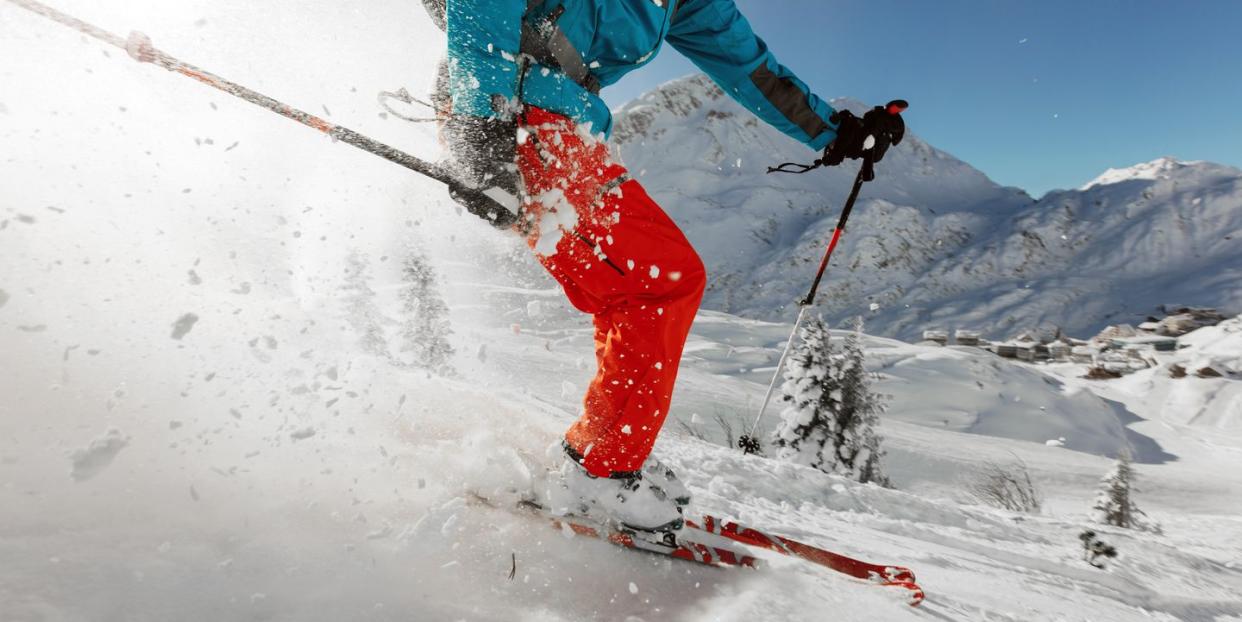
"Hearst Magazines and Yahoo may earn commission or revenue on some items through these links."
Unless you live in a ski town, managing the right ski for the right day can be tricky. You can imagine the perfect storm of ski decision making—a deep snow day when your powder planks are in for a tune, you’ve got less-experienced skiers in town visiting for the holidays, and variable crust across the mountain demands a pair of stiff, strong, all-mountain boards. Sometimes, you end up leaving the house with what’s waxed and already in the car from the last trip, only to regret that decision once you get to the mountain.
This guide can help you make the right choice. When it comes to the day-to-day workhorse, an all-mountain ski is a must-have. If you travel to ski each winter, an all-mountain ski relieves the stress of obsessive packing, renting equipment, or stressing about not having the right ski for the job, no matter what the weather holds in store for your week.
If you’re new to skiing, having the right mountain ski alleviates the pressure of terrain choice, opening up more opportunities on the mountain. For the budget savvy, one pair of skis is cheaper than owning multiple, and gives some guarantee of a ski that can handle almost every situation you throw at it.
Best All-Mountain Skis
The Expert: When it comes to skiing, I was a late bloomer, but quickly made up for it by dedicating my life to the sport and the industry, moving to Steamboat Springs, Colo., after college. I grew up playing ice hockey, but being in Tennessee, and then Kansas City, in a middle-class household, we weren’t skiers. It wasn’t until I was about 16 that I began taking ski trips to Colorado to Keystone, Snowmass, and a few other smaller resorts, that I knew my true calling was to be a skier. I live for getting outside every day and heading out for adventures at least a couple times a month, even if they're closer to home.
In a typical year, I try to ski anywhere from 50 to 100 days. Oftentimes those days are focused on testing new skis, bindings, boots, apparel, helmets and goggles, and other accessories like packs. I ski more backcountry than lifts, but still have plenty of time running hot laps at a resort, especially when ski testing is involved.
What to Consider When Choosing All-Mountain Skis
There are some key characteristics that will play into what to buy. You will be bombarded with technical terms like waist width, flex, rocker, and sidecut radius, and you'll also need to consider a whole range of other factors like weight, length, and tip and tail widths.
All-mountain skis aren’t perfect for every condition or every skier. There’s going to be some element of compromise, but our picks for the best all-mountain skis will be suitable for almost any condition you’ll encounter on the mountain.
The construction and profiles of all-mountain skis make them competent and versatile on both soft snow and hard pack, and their shape makes them easier to turn in variable terrain, whether you luck out with a few inches of fresh snow, are laying tracks on frontside corduroy, or busting crud and bumps in the trees or under the lift.
Newer construction methods often layer vibration-damping materials and stiff alloys over lightweight wood cores. The goal is to create skis that are easy to initiate into a turn, have a certain level of snappiness, and plow through deep or variable snow, with a camber and turn radius that is still able to bite into hard pack.
When buying a pair of all-mountain skis, it is your skill level, how far you want to push yourself, and the type of terrain you plan to ski, that will most affect what skis to purchase. Of course, people are always looking for the best deal or the best all-around ski, but study our picks below, and carefully consider your end-use scenario.
Dimensions
All-mountain skis typically measure between 85 mm to 105 mm wide. Pay attention to this number, referred to as waist width, as it is a key factor in how a ski performs.
The waist width (or width underfoot, measured in millimeters) helps determine almost every other dimension of the ski. Waist width tends to set the tone for the type of terrain the ski is primarily intended for. The wider the ski, the better it floats over powder and through variable, chunky or “cruddy” conditions.
Skinnier skis (below 100 mm) are typically more at home on groomed slopes, icy conditions, and frontside carving days. Widths from 102 mm to 108 mm tend to be better for mixed conditions, powder and packed powder, and what might be described as crud, chowder, or chunder. They also ski great on groomed conditions, thus the versatility of an all-mountain ski. Wider than 110 mm, and you’re starting to be more in powder ski terrain. That said, I’ve had 112 mm width all-mountain skis that I could take out in any conditions except fast icy groomed trails. For the type of skiing most people do, especially back east, look for something a little narrower with more camber and sidecut.
Skis for beginners are shorter in overall length, usually measuring to your chin when stood upright on the ground. Intermediate and advanced skiers will have skis that measure to the nose or above the brow. And beginner skis will often have a little more flex. Stiffer skis require the skier to push into the fronts of their boots more powerfully and down through the feet, so confidence to turn and a willingness to gain speed is a must.
Rocker and Camber
Even though rocker is less of a buzz word than it was 10 years ago, it still reveals a lot about how a ski will feel and turn on the snow. Rocker describes how close to the tip and tail the ski starts to bend upward. In other words, where the ski’s camber (the arc that lifts the middle section of an unweighted ski off the snow) ends. With more camber, the ski is able to offer a better hold on hard snow and carve better. More rocker conversely helps the ski float and glide better in deep snow.
“More rocker also reduces the ski’s effective edge,” says Andrew Couperthwait, Head’s senior business manager and alpine product manager. “The ski won’t bite into hard stuff as well, but you won’t have to lean the ski over as far to start your turn.” When designers get the mix right, skiers are rewarded with an energetic, intuitive ride.
Turn Radius
This is a measurement of how curved the ski is. Turn radius is based on a ski’s sidecut and length. The difference in width between the skinniest and the fattest part of the ski gives you the sidecut measurement. Turn radius is derived from sidecut but is measured by the skis effective edge (the part of the ski edge that would sit on the snow, which generally excludes the far ends of the tip and sometimes the tail, depending on shape/design.
Most all-mountain skis have a turn radius in the 15 to 20 m range. The shorter the turn radius, the easier and more compactly a skier will be able to turn. A larger turn radius (above 20 m) will yield longer turns.
Length
Essentially, the longer the ski, the faster you go, and the harder it might be to turn. Choose a shorter ski as a beginner. It's also important to factor in your overall athletic ability.
Weight
Heavier skis charge harder, bust through crud easier, and enable you to go faster. Lighter skis are better for touring and quicker turning, and for lighter skiers.
Less weighty skis will also have what is referred to as a lighter “swing weight,” meaning they are better for aerial moves and quicker, more dynamic turns around bumps and trees. Lighter skis are also preferred for touring, where you put skins on the bottom of your skis and climb uphill.
How We Evaluated All-Mountain Skis
For this roundup, I focused on a ski’s dimensions (primarily waist width or width under foot), turn radius, rocker profile, available lengths, and weight. From the famed East Wall at A-Basin in Colorado to hardpack groomed trails at Vermont's Stowe, I took laps that pushed these planks to the max. Last spring, as I do every year, I tested more than a dozen of the latest all-mountain skis across Colorado and beyond.
In addition, I relied on the previous test experience of Louis Mazzante, who did some legwork with these product selections.
BEST OVERALL
DPS Pagoda 100 RP
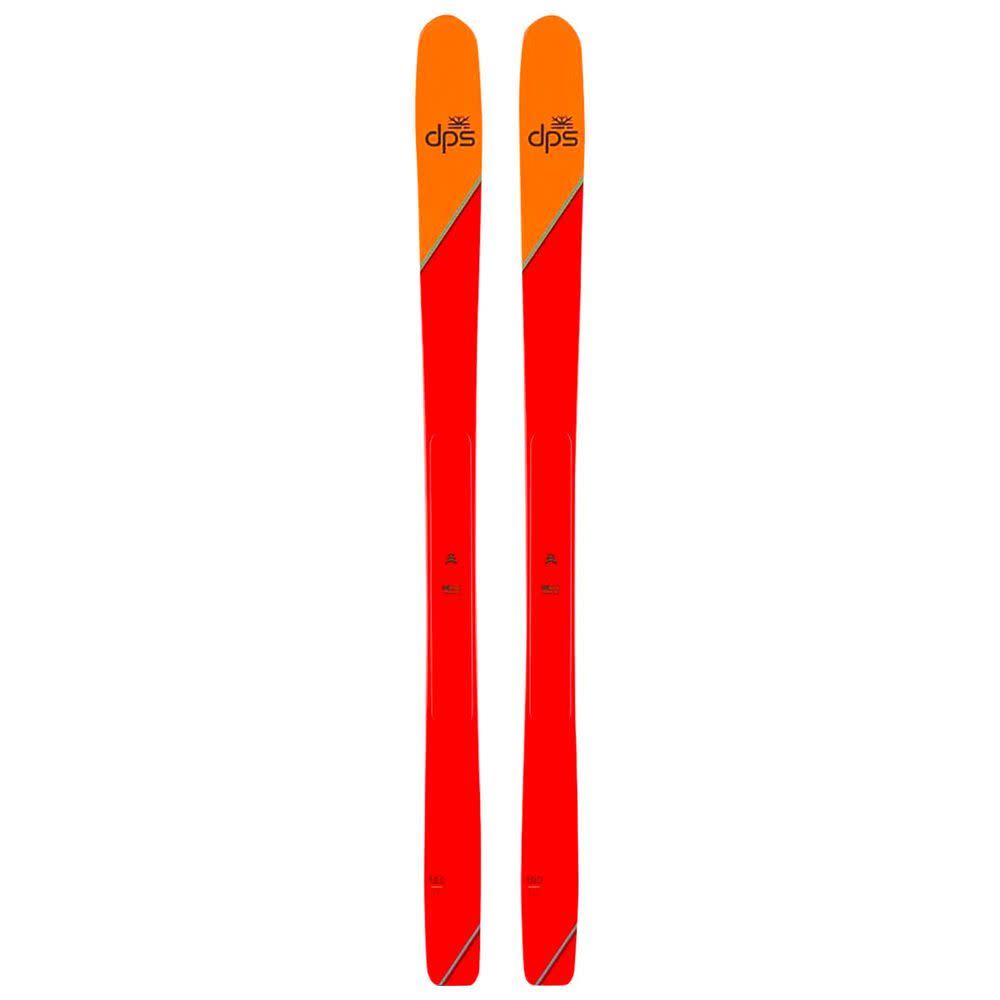
Pagoda 100 RP
$1549.00
backcountry.com
The Pagoda 100 RP sits between the DPS Pagoda Piste and Pagoda Tour, serving as a perfect hybrid of off- and on-piste design. The 100 mm under foot is the perfect width for an all-mountain ski— not limiting you from experiencing the entire mountain but still trim enough for tackling groomed trails or hardpack should the need arise. This DPS ski has unique fiberglass construction, and special resort powder (RP) shaping keeps you ready for when new snow falls.
Plenty of rocker at the tip and tail kept the Pagoda afloat in deep snow, but the shorter turn radius makes it nimble in the trees. Seek out some pillow lines under the lift then transition back onto smooth corduroy with ease.
BEST VALUE
Salomon QST 106
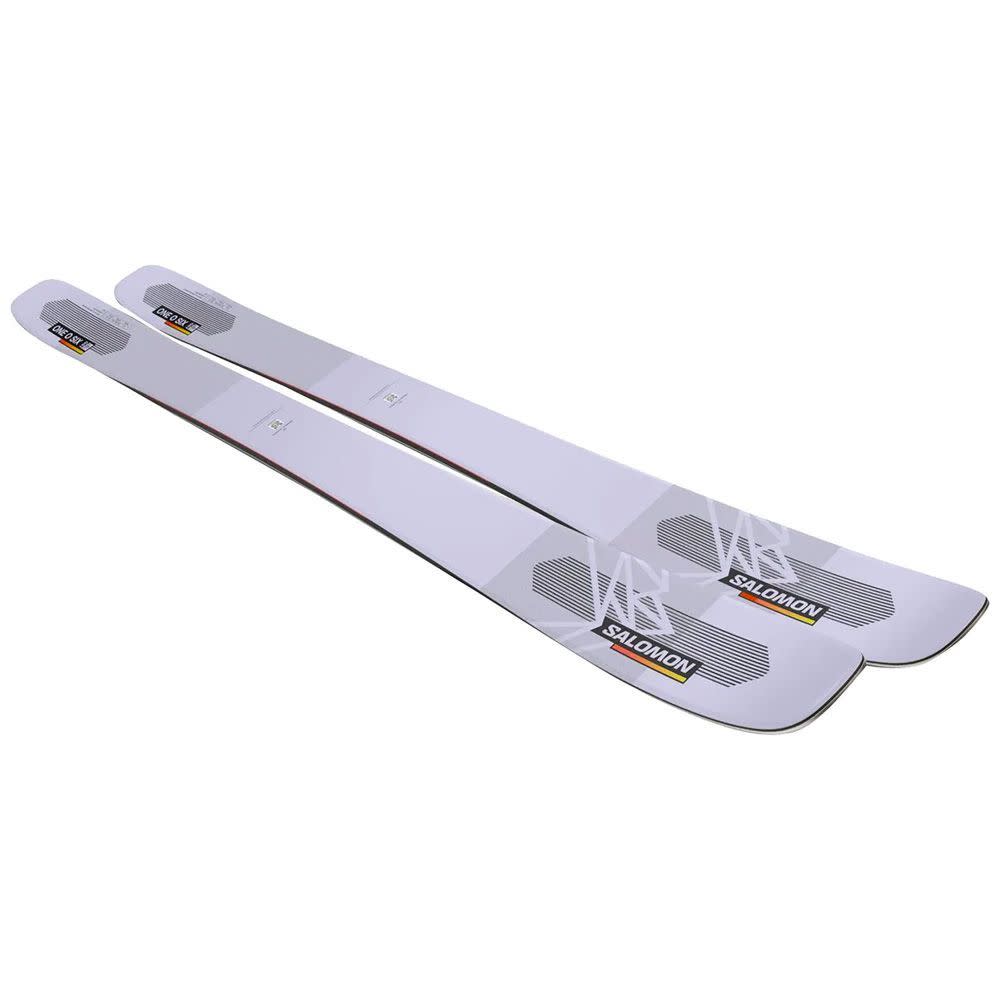
QST 106
$749.95
backcountry.com
Revamped, the Salomon QST is a resort charger that remains a pivotal value amongst all-mountain skis. More rocker and a more tapered design (Salomon has moved the widest points of the tip and tail closer to the center of the ski) makes maneuvering and pivoting this ski easier in tight spots and still allows for playful turns on the frontside, even at 106 mm underfoot.
We were especially impressed by this ski’s stability, combined with cork “damplifier” technology and double sidewall underfoot that minimizes chatter and lends confidence. The QST is lightweight and wide enough for the backcountry as well, making this ski a highly versatile beast for under $800. It’s also available in a QST 92 mm underfoot for those looking for something more frontside oriented.
BEST FOR BEGINNERS
Rossignol Experience 86
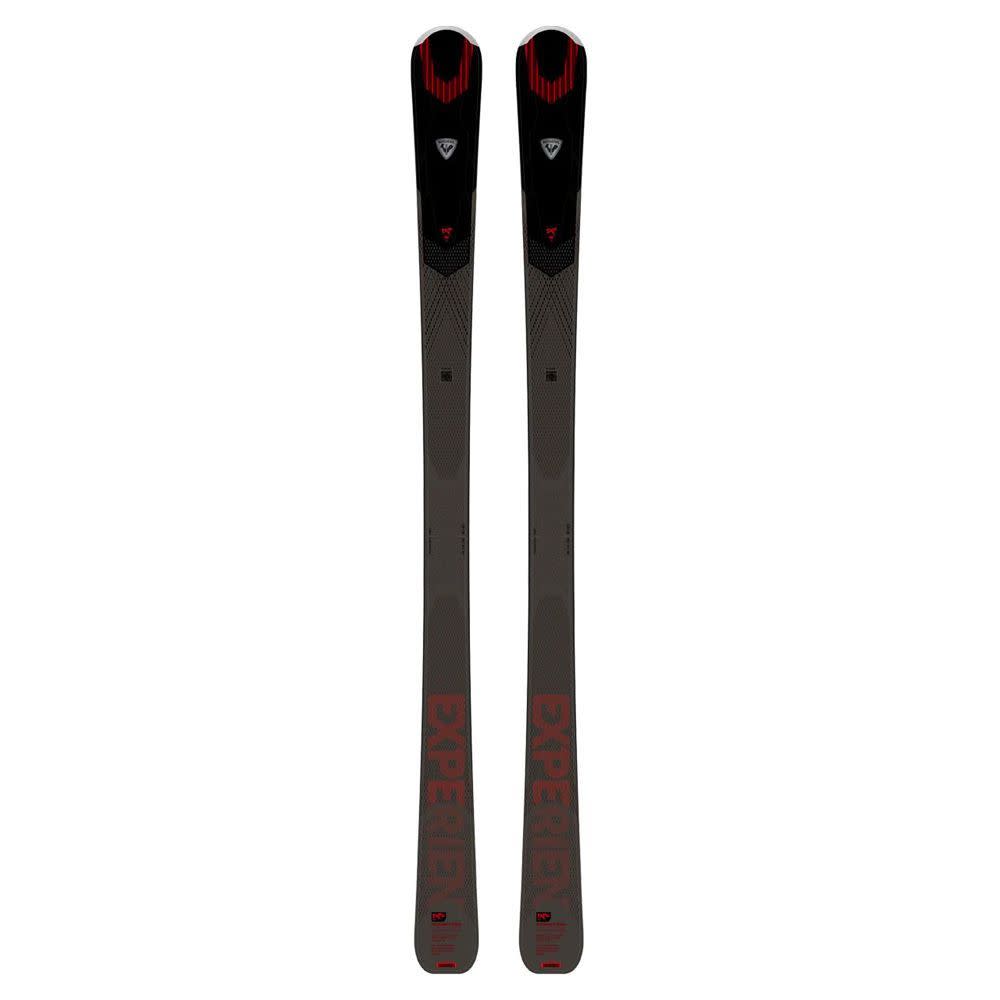
Experience 86
$899.95
backcountry.com
This is what might be considered a more classic all-mountain ski from a classic all-mountain brand. With a waist underfoot of just 86 mm, Western skiers would tend to consider this more of a frontside or on-piste ski, whereas 86 mm underfoot might seem more versatile to an East coast skier, but either way it is quick to turn, especially on hard pack snow. Also like a traditional all-mountain ski, the Experience line boasts early-rise tips to help beginners bust crud and float effortlessly, while the use of stiff metal titanyl reinforces your ability to power this ski down any slope angle. Even at its longest length of 185 mm, it skis like a longer ski due to well-engineered edge hold and sandwich construction.
BEST WOMEN'S SPECIFIC
Blizzard Sheeva 10
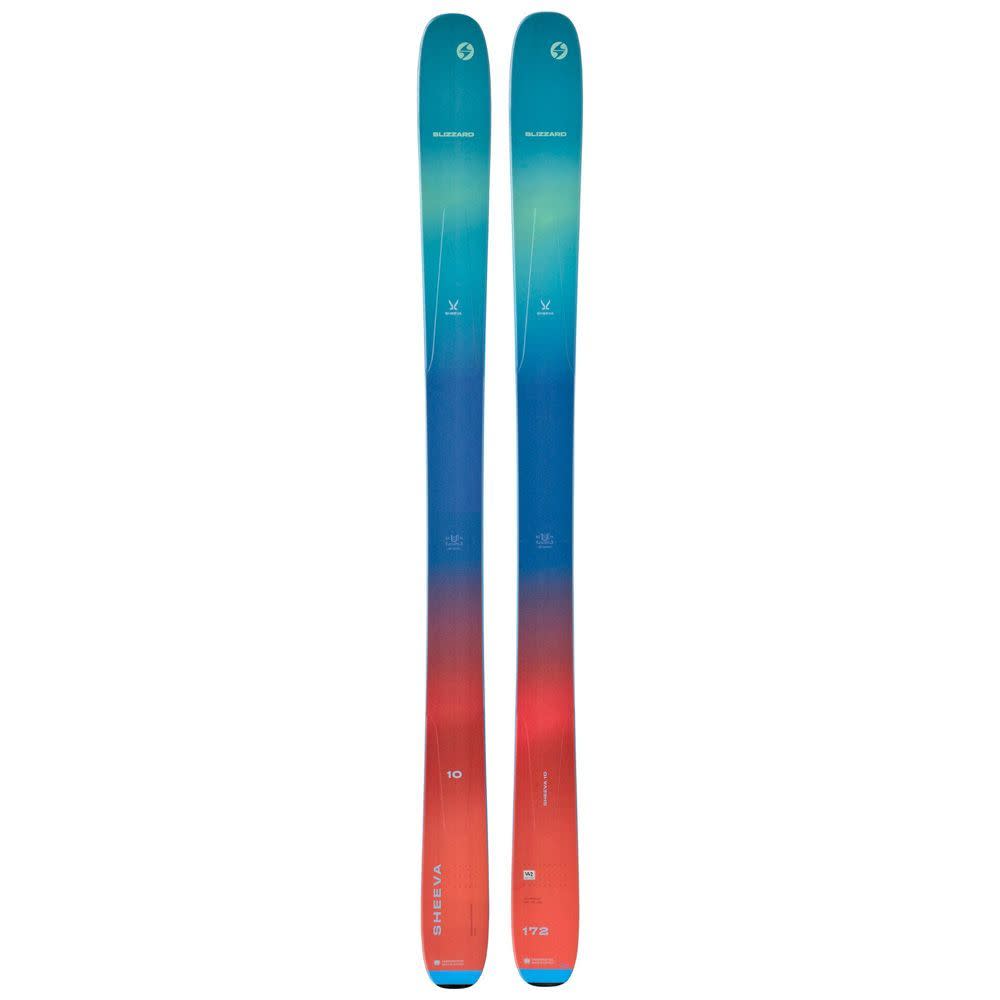
Sheeva 10
$699.95
rei.com
You’re bound to see a lady-shredder on a pair of Blizzards these days. If you want something for any possible condition from coast to coast, this wider all-mountain ski is a powder surfer, but carves surprisingly well on groomed trails too. The Sheeva’s Women-Specific Design incorporates a lighter core that delivers playfulness without compromising stability. With a progressive shape leading to a wide rocker tip, its Carbon Flipcore “Dynamic Release Technology” sets the Sheeva up for success on softer snow yet won't slow you down on your way there.
BEST FOR POWDER DAYS
Nordica Enforcer 100
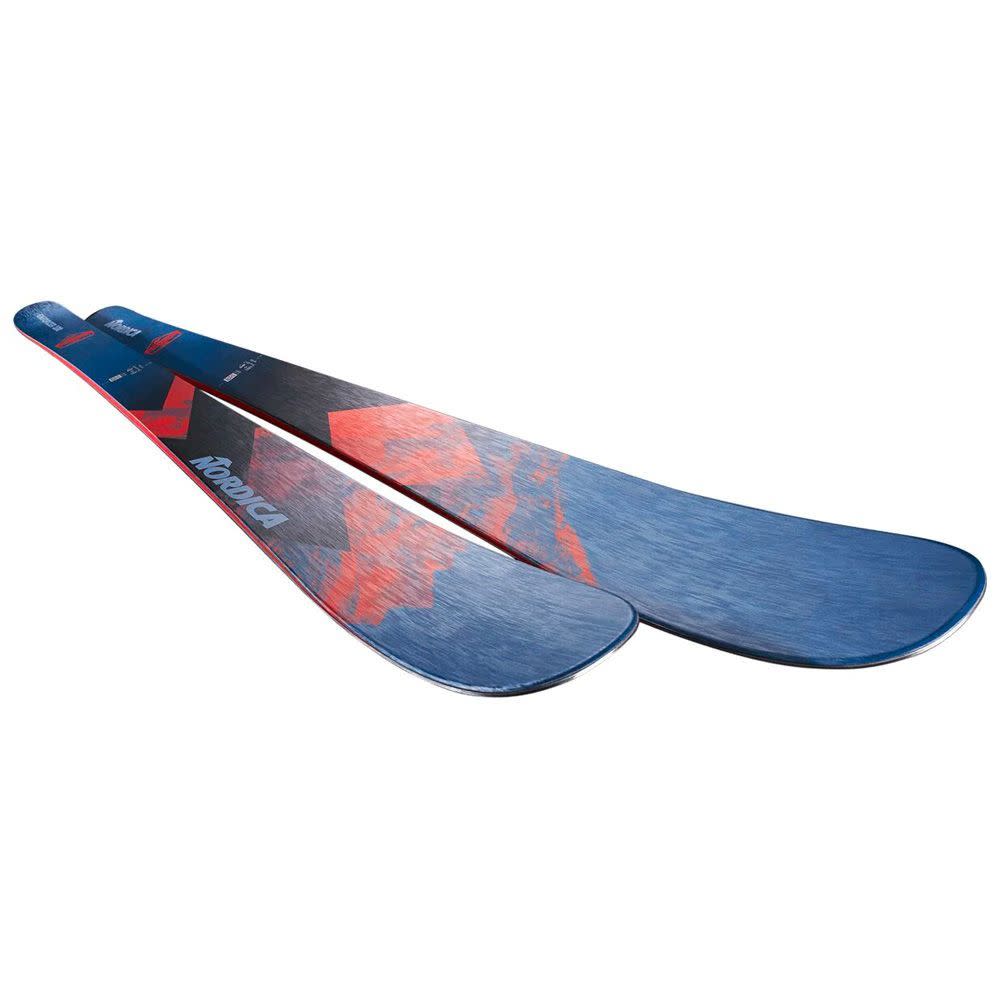
Enforcer 100
$799.95
backcountry.com
One of the most highly rated and best-selling skis of all time, the Enforcer continues to deliver. This ski is stiff, so it shines brightest when you’re plowing through variable snow or pushing big lines. And its 100 mm waist falls right into that meaty part of the all-mountain spectrum for confidence on any terrain. What you might miss in playfulness, you gain in stability, thanks to Nordica’s new Carbon chassis improving torsional stiffness. Tap into your inner ski racer, whoop it up in the back bowls, or land some 180s off the kickers in the park—the Enforcer has you covered with a wide range of lengths from 165 to 191.
BEST FOR HARDPACK
Atomic Maverick 100 Ti
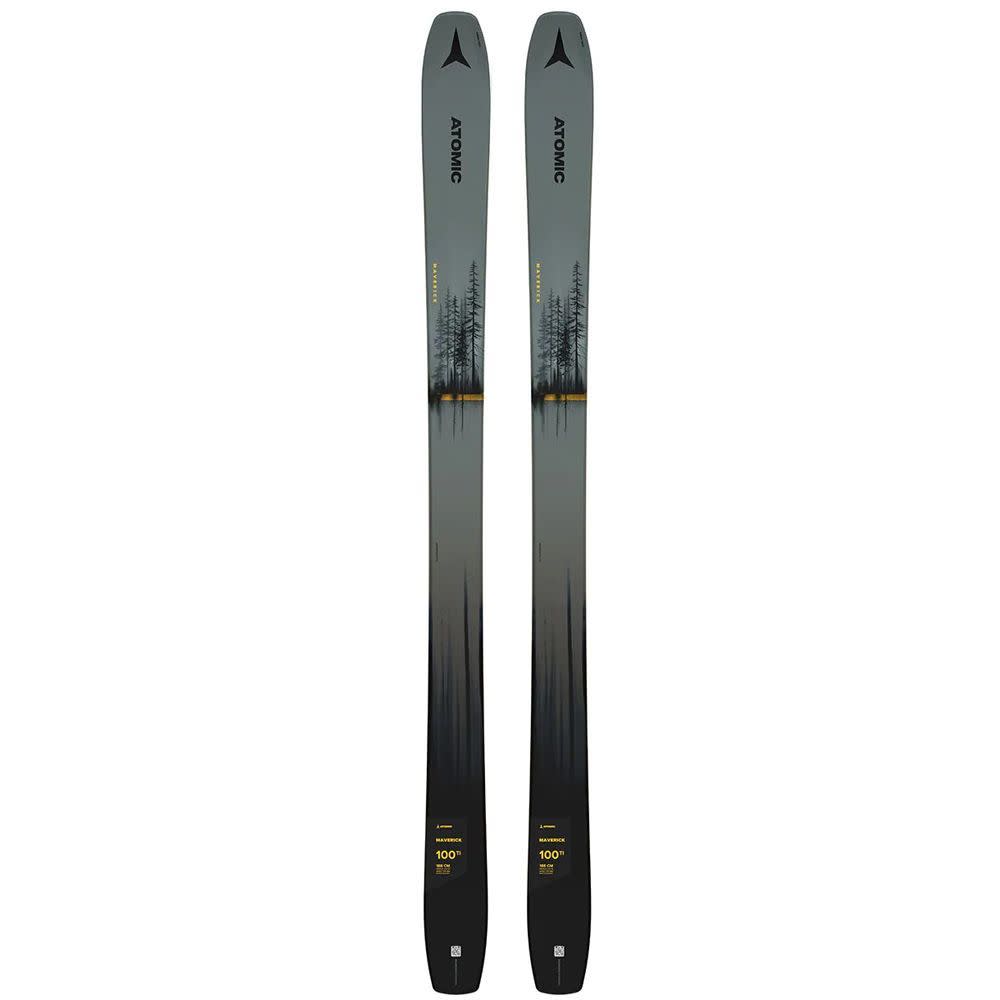
Maverick 100 Ti
$600.00
backcountry.com
At 100 mm underfoot, the Atomic Maverick 100 Ti slices into corduroy but still floats like a dream when conditions demand—a true all-mountain ski by any standard—and is the widest ski in this Maverick family by Atomic. Despite its stiffness, the Maverick is still fairly lightweight, now with increased tip and tail rocker, and camber underfoot. The ski relies on a Titanal laminate to stiffen its poplar core. It is energetic and poppy with a healthy turn radius—our favorite all-mountain ski for fast, icy groomed runs. While a 100mm ski may at one time have seemed more powder-oriented, today 100 underfoot is an ideal compromise for all-mountain performance, and the Atomic Maverick 100 skis like a skinnier carving ski on icy conditions, yet still floats, schralps and surfs pow.
BEST FOR SIDECOUNTRY
Dynastar M-Free 108
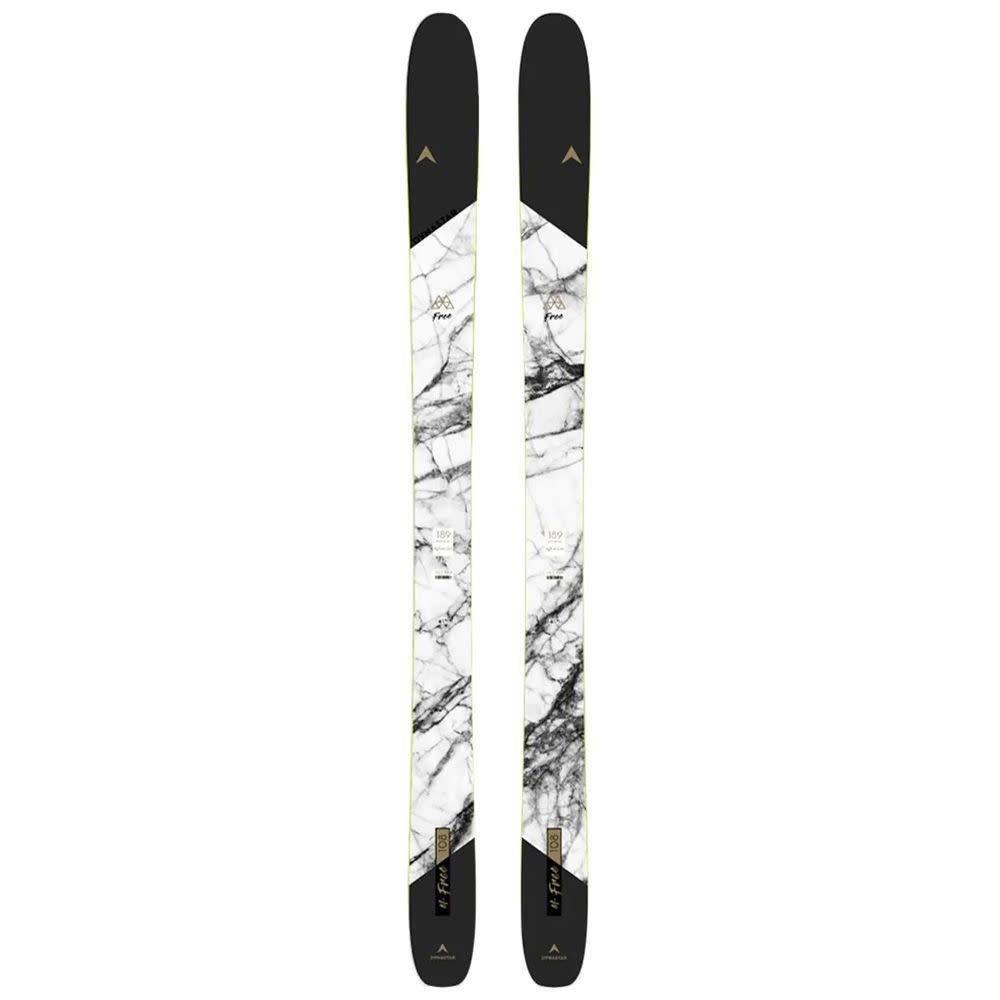
M-Free 108
$799.95
backcountry.com
The M-Free 108 is floaty yet primed for quick maneuvering, stiff underfoot, and versatile and energetic, due to its pronounced rocker in the tip and tail. In hike-to terrain, we could skirt around rocks and pounce into powder with ease. This ski is beefy, though, and built for stability and power. While it might be too much ski for some, it will be the perfect mix of camber and rocker and provide durability across all types of terrain.
BEST FOR EAST COAST SKIERS OR VARIABLE DAYS OR FRONT SIDE
Head Kore 93
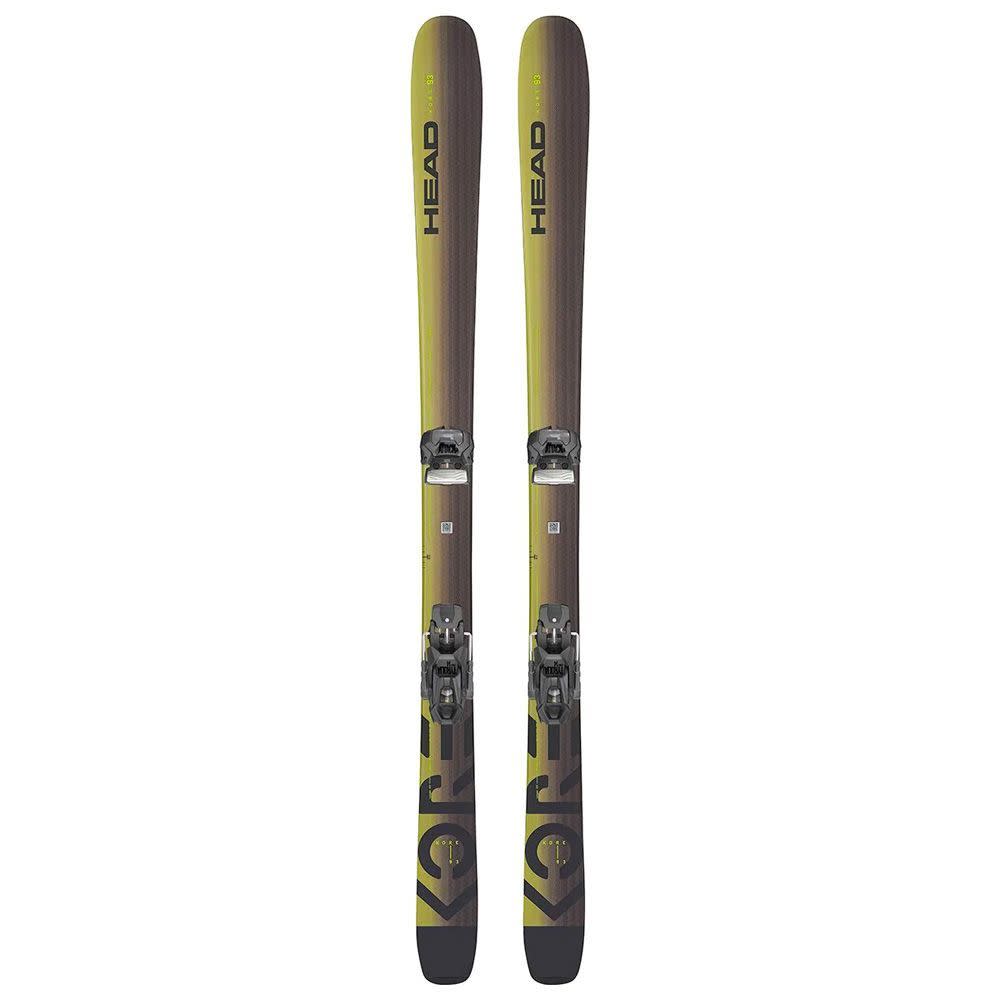
Kore 93
$748.95
backcountry.com
You may recognize HEAD skis fif you watch the Winter Olympics. HEAD's Kore line takes that Olympic level technology and dumbs it down for everyday all-mountain skiers perfectly. At a moderate yet versatile 93 mm underfoot, it’s stable and aggressive at the same time and wide enough for a powder day. It is fast edge-to-edge with a typical camber underfoot, imbued with a bit of rocker to help it moderate the turn radius. With vibration dampening material beneath the bindings strung together with a mix of graphene and fiberglass throughout the core, the HEAD Kore has a unique blend of light weight, stiffness, and pro-level playfulness. Head also offers a women’s version, the Kore 93W, which is made the same way and comes in shorter sizes.
So Many Factors Go Into Choosing the Right Skis. Expert Aaron Bible Decodes Ski Speak So You Can Get Your Perfect Pair.
PM: How does the type of terrain dictate ski choice?
AB: Skiers might choose their ski of the day based on prevailing conditions. Ski racing and carving, arcing big deep swooping turns down groomed or icy runs, necessitates a completely different ski than powder surfing does. Those might be your two extremes. But this is also why the “all-mountain” ski has become so popular.
The choice then becomes more about size, weight, skiing ability, personal skiing style, and preferences. In its purest form, the all-mountain ski has enough camber and sidecut, balanced with enough width and tip rise (among other more subtle design factors), to ski powder, crud, trees, and groomed slopes competently. A ski won’t make you a good or a great skier, but the right ski for the right day will make a beginner skier have more fun and ski like an intermediate, and an intermediate skier advanced.
PM: What about the difference between men’s and women’s skis?
AB: This is another lengthy and sometimes contentious topic. In the past, top sheets (the graphics) and the color palettes of women’s and men’s skis would vary, and sometimes that was their only difference. Now, while some brands still have women-specific skis or graphics, or use certain color or design elements to indicate gender, most are steering away from that, and are making skis “unisex.”
While women’s skis were traditionally shorter, smaller, or less-stiff, almost sized-down versions of men’s skis, most brands realized that what you’re really talking about is skier weight and size, not gender or ability. So modern skis are made more for a weight range and/or a performance characteristic versus a gender distinction.
PM: Is it better to have rocker, camber, or a hybrid?
AB: Ah yes, another great question that has no right answer! All skis have a little bit of both, and therefore, almost every ski you come across is a hybrid. Just about every ski has some camber, and a smaller percentage of skis, such as WNDR out of Salt Lake City, offer a “flat” or zero camber version of a ski model.
While fully rockered skis were a fad for a little while, and many still employ them exclusively for powder skiing, it is rare to see a fully rockered ski at a resort. For the most part, ski makers have come to agree that some degree of camber underfoot is ideal for turning, not just on groomed or hard packed surfaces, but for most snow surfaces you’ll encounter. Flat, zero-camber skis can also be turned nicely on hardback and are really quite fun, they just aren’t designed for it. And that said, no matter how much camber a ski has underfoot, it will still have rocker in the tip and tail.
The big design consideration today is where the tip and tail rockers start and how stiff is it. Early-rise is a common buzzword for all-mountain skis because it gives you the camber underfoot for groomed skiing, but a shovel-head tip that busts crust and crud and can get on top of deep snow. For more aggressive skiers, or big-mountain skis versus all-mountain skis, you’ll find less tail rocker and a stiffer tail for landing jumps and slashing turns. But a softer, more shoveled tail can be more playful and easier to maneuver through variable conditions and bumps.
You Might Also Like
